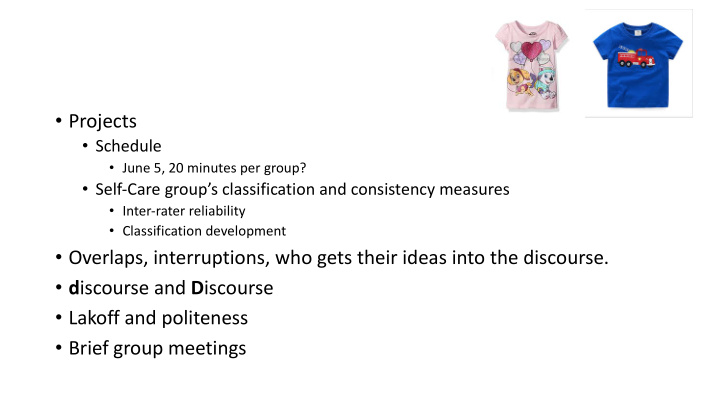



• Projects • Schedule • June 5, 20 minutes per group? • Self-Care group’s classification and consistency measures • Inter-rater reliability • Classification development • Overlaps, interruptions, who gets their ideas into the discourse. • d iscourse and D iscourse • Lakoff and politeness • Brief group meetings
Mehl, Matthias R., Vazire, Simine, Ramirez-Esparza, Nairán, Slatcher, Richard B. and Pennebaker, James W. 2007. Are women really more talkative than men? Science, 317.5834 p.82.
Leaper, Campbell and Ayres, Melanie M. 2007. A meta-analytic review of gender variation in Adults' language use: Talkativeness, affiliative speech, and assertive speech. Personality and social psychology review, 11.328-63. • Men talk more than women in: • formal situations & task-oriented activities • in studies that take place in universities • in mixed-sex groups • with strangers & mixed-familiarity groups • in dyads • with spouses & partners • Women talk more than men: • with their children and classmates
Kollock, Peter, Blumstein, Philip and Schwartz, Pepper. 1985. Sex and power in interaction: Conversational privileges and duties. American sociological review, 50.34-46. Study of 20 cross-sex and same-sex couples: • partners in power-balanced couples talked the same amount • when there was power asymmetry • in same-sex couples, the more powerful member talked more • in heterosexual couples, the man talked more regardless of power (both members talked more than in other couples and the disparity between m and f was even greater)
Eskilson, Arlene and Wiley, Mary Glenn. 1976. Sex composition and leadership in small groups. Sociometry, 39.183-94. • 144 undergraduates doing tasks in triads • 1 member designated as expert on the basis of having done better on a bogus test • “Expert” spoke more than others regardless of gender
Dovidio, John F., Brown, Clifforde., Heltman, Karen, Ellyson, Steve L. and Keating, Caroline F. 1988. Power displays between women and men in discussions of gender-linked tasks: A multichannel study. Journal of personality and social psychology, 55.580-87. • 88 undergraduates asked to rate on a scale of 1-10 how familiar they were with each of 14 everyday activities. Selected 3 topics: • male gendered: changing oil • female gendered: sewing • non-gender-linked: gardening • paired 24 mixed-sex dyads to have 3-minute conversations. • males talked more in conversations about male and non-gendered topics • females talked more (but with less of a difference) in conversations about female topics
Expertise as entitlement How is expertise determined?
Knowledge, Entitlement, and Legitimacy • who can wear the trendy outfit first? • who can introduce a new word or usage? • who can use the dialec t? • who can use the language? • Who can participate in the speech event? • Who can be present in the situation? • Who gets to interpret events? • Who can create a silence? • Who can end an interaction?
Centrality of conversation • Electrons as particles and waves • Performativity • . . .
Discursive construction of gender • The Gender Order: Social structures, institutions and practices that maintain and reproduce patterns of gender differentiation and relations of power. • Discourse – from today’s conversation to “common sense”. • Gender and getting one’s stuff into the discourse • getting it into the conversation • getting it understood • getting it beyond the conversation • Common sense is positioned • ideology • Foucault, Michel. 1980. The history of sexuality. New York: Vintage Books. • Eagleton, Terry. 1991. Ideology: An introduction. London and New York: Verso. • habitus • Bourdieu, Pierre. 1977. Outline of a theory of practice. Cambridge: Cambridge University Press. • Dominant and subaltern discourses
Beginnings of the study of language and gender: Lakoff, Robin. 1973. Language and woman's place. Language in society, 2.45-80. Book version. 1975. Language and woman's place. New York: Harper and Row. • The marginality and powerlessness of women is reflected in both the ways women are expected to speak, and the ways in which women are spoken of. • In appropriate women’s speech, strong expression of feeling is avoided, expression of uncertainty is favored, and means of expression in regard to subject matter deemed ‘trivial’ to the ‘real’ world are elaborated.
Women’s language use according to Lakoff • elaborated lexicon on ‘unworldly’ topics (e.g. color terminology) • weak expletives: oh dear , fudge • terms denoting approval of the trivial: lovely , divine • tags: The war in Vietnam is terrible, isn’t it? • rising intonation: • When will dinner be ready? • Oh, around six o’clock? • compound requests: Won’t you close the door? Deference Submission to the opinion, wishes, or judgment of another. Respect and esteem due a superior or an elder
Fa Face • An image of self delineated in terms of approved social attributes. • Reflects concern with a sense of congruency between one's performance or appearance and one's real worth. • Can be maintained, saved, threatened, or lost. Goffman, E. (1967). On face work. In Interaction Ritual (pp. 5–45). New York: Doubleday.
Politeness • Situated forms of conduct that enhance, and prevent or repair infringements on, others � face. • Positive politeness: Directly shows solidarity, appreciation for the other. (e.g. compliments, inclusiveness) • Negative politeness: Shows respect for hearer’s autonomy. (e.g. apologies, indirectness) Brown, Penelope & Stephen Levinson. 1987. Politeness: Some universals in language use.
Recommend
More recommend